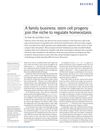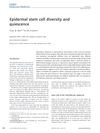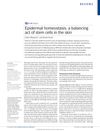19 citations
,
February 2013 in “Archives of Dermatological Research”  34 citations
,
June 2008 in “In vitro cellular & developmental biology. Animal”
34 citations
,
June 2008 in “In vitro cellular & developmental biology. Animal” Scientists created a long-lasting stem cell line from human hair that can turn into different skin and hair cell types.
201 citations
,
May 2001 in “Proceedings of the National Academy of Sciences” The study investigated the effects of COX-2 overexpression in the skin of transgenic mice, revealing that it led to increased prostaglandin levels and a pronounced skin phenotype. This included reduced hair follicle density, delayed hair follicle morphogenesis, and thinning of the interfollicular epidermis. Adult mice exhibited a sparse, greasy hair coat due to sebaceous gland hyperplasia and increased sebum levels. Additionally, hyperplasia of the scale epidermis in tail skin was observed, attributed to abnormal epidermal differentiation rather than increased cell proliferation. The study highlighted a causal link between COX-2 expression in basal keratinocytes and epidermal hyperplasia, along with dysplastic features at specific body sites.
149 citations
,
July 2000 in “Molecular and Cellular Biology” The study investigated the role of keratin 6a (MK6a) in wound healing by creating MK6a-deficient mice. It was found that MK6a was normally induced in the outer root sheath and interfollicular epidermis upon wounding in normal mice, while MK6b was only induced in the suprabasal layers in MK6a-deficient mice. These MK6a-deficient mice exhibited delayed reepithelialization from hair follicles after superficial wounding, although full-thickness skin wound healing was unaffected. In vitro, keratinocyte migration and proliferation were not impaired in MK6a-deficient mice, and neither MK6a nor MK6b was expressed in keratinocytes of full-thickness wounds. The findings suggested that MK6a was not crucial for keratinocyte proliferation or migration but played a role in activating follicular keratinocytes after wounding, marking the first report of a keratin null mutation leading to a wound healing defect.
30 citations
,
October 1999 in “Differentiation” 94 citations
,
October 1994 in “The Journal of Cell Biology” 198 citations
,
November 1989 in “The Journal of Cell Biology” 156 citations
,
January 1989 in “Genes & Development”





